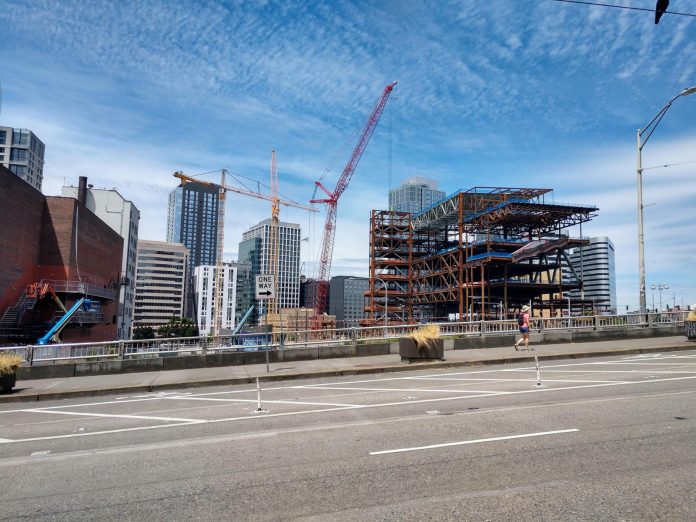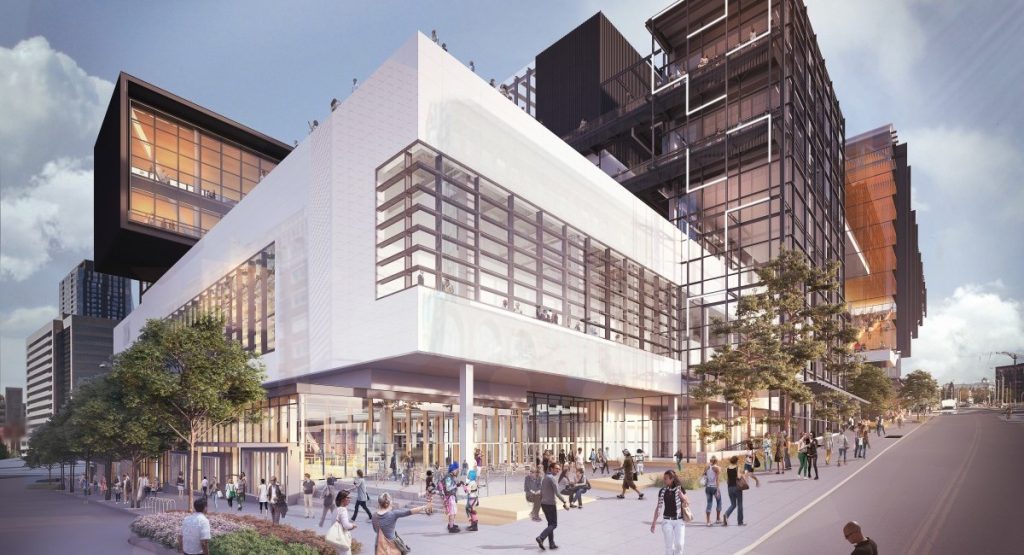
On Thursday, King County Executive Dow Constantine outlined his plan to loan $100 million to the Washington State Convention Center (WSCC) to prevent a construction stoppage on its now $1.9 billion expansion, which he portrayed as 80% done.
Plenty of questions remain. The terms of the deal were not released beyond a 1% interest rate that seems pretty generous considering the risk involved, and brushing aside those concerns by saying that the return on investment is similar to what the County’s $3.4 billion investment fund averaged in the bank is hardly convincing. The County is taking on risk by loaning money to a troubled enterprise like the WSCC and it’s consuming borrowing capacity, hazarding that future loans will get worse rates if the County’s credit rating suffers in the process.
Earlier this year, developer Matt Griffin revealed the project has a $300 million shortfall, which suggests the project is still $200 million in the hole. County officials said they had provided a “template” and suggested that the City of Seattle and the State of Washington will each chip in their own $100 million low-interest loans. They have yet to make such a commitment, though a spokesperson for Governor Jay Inslee did express interest in working on it with the state legislature.
The convention center has pitched itself as too big to fail, and the County pointed directly to the ultimatum it had received in its press release: “The Convention Center indicated that if a solution to the $300 million funding gap is not found in the coming weeks, it will be begin taking steps to shut down the project in the spring, letting go of 1,000 construction workers.”
Labor heard the threat. Nicole Grant, executive secretary of the MLK County Labor Council, spoke on behalf of the project, which to its credit created a robust apprenticeship program responding to the demands of labor leaders. “We cannot stop,” she said. “Thousands of jobs are on the line.”
Whether his hand was forced or not, Constantine stressed the benefits during his media tour on Thursday.
“It was clear to me we had to do something to make sure the project is done on time, that those construction workers stay employed and that our visitor industry benefits from this asset as soon as possible,” Constantine said in an interview with Puget Sound Business Journal.
When asked during his press conference what assurances the County has that the loan will be repaid or that the convention industry would recover, Constantine suggested such doubts were unfounded and betrayed a lack of faith in Seattle. He called it a “safe investment” and predicted a strong rebound in travel and tourism. (And apparently trade expos and business conventions are what people have in mind once they have a vaccine coursing through their veins.) The WSCC’s finances are backed by a hotel tax gathering revenue from all hotel stays in the county at a rate of 7% in Seattle and 2.8% elsewhere–regardless of whether they are related to a convention. That broad tax could help overcome shortcomings of the convention business, but it would also mean the convention center is skimming revenue that likely wouldn’t have happened anyway rather than creating it anew.
Critics question whether the public can really recoup the nearly two billion dollars that have been pumped into this project. One of the sharpest critics has been architect David Dahl who has penned op-eds in both The Urbanist and Crosscut.
“Expanding the Washington State Convention Center was a mistake, with obvious flaws in the data that was used to promote the expansion,” Dahl wrote. “The current crisis has only accelerated a trend of diminishing returns on convention center construction that has been ongoing for decades.”
The pandemic could dampen demand for large in-person gatherings for quite some time, particularly as companies have invested in conferencing software and hardware and gotten comfortable with it, Dahl suggested.
“The technological innovation that powers much of the regional economy (and will be the likely centerpiece of the region’s recovery) is actually pushing convention centers as a building type towards obsolescence,” he added. “Rather than rushing to throw good money after bad, our elected officials should be questioning why so much public money was poured into such a dubious investment in the first place.”
Thanks to advocacy from the Community Package Coalition, the expansion’s public benefits package did swell in size to $83 million, which still remains less than 5% of the project budget. Notable investments include $29 million in affordable housing, $10 million to improve Freeway Park, $10 million for Pike/Pine bike improvements, and $10 million for pedestrian improvements. If the convention center expansion stalls out or goes under, it’s not clear what would happen to that package, although some of the bike improvements have already been delivered.
In his analysis, Dahl laid out how attendance levels essentially stayed flat even as the convention center doubled in size in 2001. The 9/11 terrorist attacks and the Great Recession wiped out the convention business, and it’s not clear growth imagined before those crises is possible. Dahl advised against selling the County-owned Convention Place Station to the WSCC to make way for the expansion in the first place, citing the shaky fundamentals of the project. The seller financing the County generously worked into that $161 million deal may have left it even more exposed if the WSCC becomes insolvent, since much of the money hasn’t been paid yet.
The 1.6 million square foot expansion will nearly quintuple the size of the convention from its current 414,722 square feet. Will this much larger expansion succeed in greatly boosting attendance where the previous one failed? It’d be a bit easier to be confident if every major city wasn’t also gearing up its own convention center, some similarly seeking loans to power through the pandemic. Seattle was cited in a recent New York Times article about convention centers doubling down amidst the recession alongside a handful of other cities. If the hope was that Seattle would gain an advantage by opening a huge convention center expansion during a recession, that appears unlikely since peer cities are making similar gambles.

Nonetheless, Executive Constantine is staking his reputation on the convention center expansion as he tools up his run for a fourth term leading the county. Easily my most memorable experience at the convention center was seeing the Raging Grannies interrupt a Constantine speech to protest the new youth jail during the Go Green Conference and getting carried out singing by security. The youth jail (or officially the Child and Family Justice Center) is familiar because it’s another example of the executive making sure a controversial megaproject gets built.
On the other hand, Constantine’s strong support of light rail expansion shows he’s also committed to worthy megaprojects, and he can point to successes like passing Sound Transit 3 and leading the Sound Transit Board as it planned the program. In his part three campaigns, Constantine has coasted to election against middling opponents, but who knows what to expect in 2021.
Update: Later in day Tuesday, Moody’s downgraded the WSCC’s credit rating two notches from Baa1 to Baa3, affecting $1.3 billion in outstanding debt. The sharp drop in lodging tax revenues means the WSCC Public Facilities District means incoming revenue is less than debt payments, necessitating a dip in cash reserves and the request for bridge loans. “Management currently anticipates having sufficient unrestricted cash to cover debt service shortfalls from underperforming pledged revenues in calendar year 2021,” Moody’s wrote. “The district will continue to use the additional lodging tax revenue to provide incremental financial flexibility in the near term, including to cover debt service. The district estimates it may need upwards of $350 million in additional funds to complete ongoing capital projects, with additional funding needed within the next six months to prevent meaningful stoppage on current construction activity.”
Doug Trumm is publisher of The Urbanist. An Urbanist writer since 2015, he dreams of pedestrian streets, bus lanes, and a mass-timber building spree to end our housing crisis. He graduated from the Evans School of Public Policy and Governance at the University of Washington in 2019. He lives in Seattle's Fremont neighborhood and loves to explore the city by foot and by bike.

